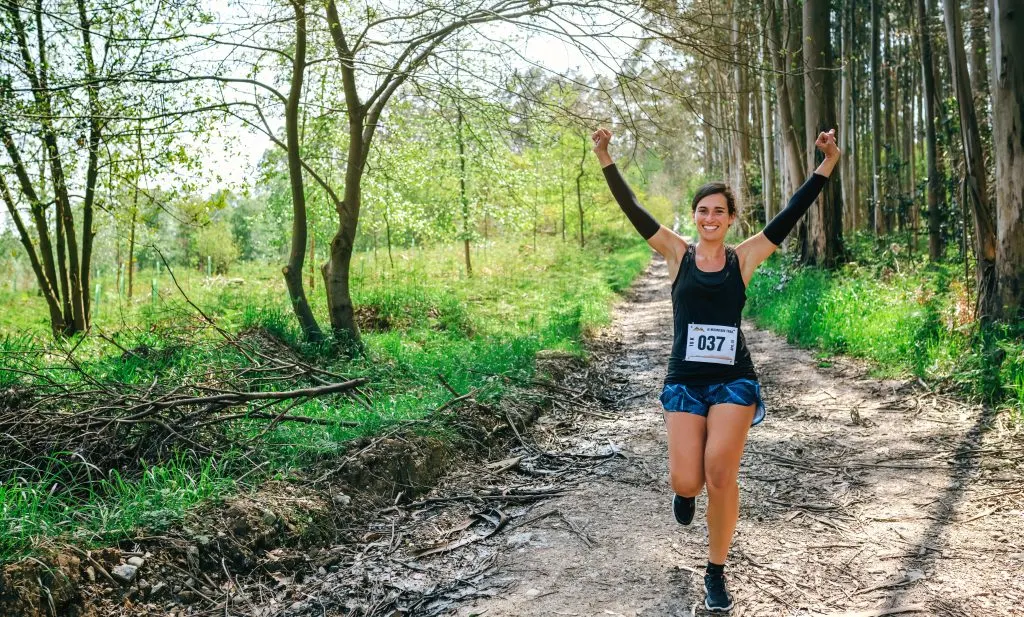Have you ever heard of fartlek training? If not, you may have done it without knowing it is called fartlek training.
Either way, fartlek training is among the most efficient ways of building intensity whenever you start on any race, and you are missing out if you haven’t tried this technique.
In this article, we will discuss extensive details about fartlek training and how beginners can use it to their advantage to create the most effective training sessions.

What is Fartlek Training?
Coined from Swedish, fartlek means “speed play” and refers to a type of race training done on individual terms. It is ideally unstructured interval training, where the runner is free to alternate between faster and slower speeds.
The point of fartlek is maintaining a stable cardio rate while varying the pace or difficulty.
For the best fartlek training, you should make your exercise fun. Run at your normal pace, randomly run faster for some time, and then go back to your normal rate.
The criteria employed to choose the intervals are generally random and unpredictable and will often vary depending on the individuals and their training environment.

Fartlek vs. Interval Training
Although they are unified by the fact that they are both aimed at improving endurance and speed, fartlek training is by far different from interval training.
Fartlek training is all about being spontaneous and unpredictable.
The runner is free to alternate their pace and speed however they want, based on their random milestones and how they see it best suited to reach them.
Conversely, interval training entails a preplanned and calculated increase or decrease of the running pace at varying intervals over set distances.
In interval training, you also slow down to walk a certain distance before picking up the pace again.
Fartlek training is also aimed at attaining varying speeds compared to preplanned training.
Fartlek training is excellent for the beginning of the training season because it helps prepare muscles and avoids overloading the cardiovascular system, enabling the body to adjust favorably over time.

There is also the time factor when differentiating the two. Fartlek training sessions are often shorter than the planned interval training sessions.
Planned training sessions are for professionals who are confident that they can endure the planned period while applying the necessary changes in speed and pace.
Fartlek training, on the other hand, is great for runners who are still training to maintain a stable pace.
Regardless of their striking differences, fartlek training and interval training are beneficial methods in any runner’s career, and both should have equal importance in a runner’s schedule.
Things to Consider When Starting Fartlek Training

- Do you have basic fitness? – You don’t necessarily have to be an experienced runner, but you have to have basic fitness. If you need to develop fitness, try walking-jogging fartlek sessions first to help build and maintain your cardio levels.
- Are you recovering from an injury? – Consult your physician before trying out fartlek training sessions. A consultation will help eliminate the risk of further damage to the injury in case you are not yet ready.
- Do you want to run with a friend? – Fartlek training is best suited for individual training sessions. Conducting group fartlek sessions can be tricky since every runner often has their own pace. However, it may be beneficial if you want to have a competition among friends.
- Do you like unstructured workouts? – If you don’t, you might find it hard to motivate yourself.
Fartlek Training Tips for Beginners
As a beginner, you might not be sure of your endurance limits. It is therefore not recommended to push yourself too far and inflict injuries on your body.
With fartlek training, you will quickly learn the paces you are most comfortable with and are free to speed-play however you want.
You are, therefore, free to maintain a comfortable, slow pace when cooling off and spontaneously speed up for high-effort runs. After your fast run to the desired landmark, slow down to your normal pace to cool off and get your breathing rates back to normal as you prepare for the next interval.

You should do it alone, but if you have a friend who doesn’t mind being unaware of the intervals, you can go in a pair. This further helps challenge teammates to compete at the same pace as other team members, pushing those reluctant individuals to keep up with the rest.
Different types of terrain work well for fartlek training.
Whether it is on a flat surface or rough terrain, on roads, trails, grass, or even on a treadmill, fartlek training is flexible with all forms of surfaces.
You might also consider adding bodyweight exercises like pushups between intervals to vary the training sessions.
Physical landmarks are always the best markers to choose when doing fartlek training.
You can use benches, mailboxes, stop signs, buildings, traffic lights, street lamps, or even trees as your desired landmarks, then quickly charge towards them until you reach them.
Remember that fartlek training is flexible, so set reasonable and achievable milestones, and the training will never get monotonous.
Benefits of Fartlek Training

- Stimulating and fun – fartlek training is spontaneous and therefore stimulating.
- Improved endurance and speed – the unstructured dashes help your muscles quickly adapt to changes in momentum, building more speed and endurance, regardless of the length of the race.
- Fartlek training is also an efficient way of introducing intense training sessions to your schedule.
- Fartlek training has a lesser risk of injuries as compared to interval training. Blending the two will ensure a risk-free training session for better results.
- Fartlek training trains you to monitor your body.
- Fartlek helps you get used to instant pace changes.
- Saves time – adding quick dashing sessions to your general training session makes your session shorter.
- Sports training – various athletes like hockey or football players often have to switch from a jogging pace to a quick sprint in a game. Fartlek is excellent for developing that pace-switching ability.
Types of Fartlek Workouts
There are no rules for doing fartlek workouts. But here are some of the primary ways of doing these unstructured workouts.
1. Landmark Fartleks

Plan to run a 3- to a 4-mile route.
- After a relative warm-up period of about 10 minutes or more, pick a landmark like a mailbox or a tree.
- Then dash to it as fast as you can.
- Once you reach the landmark, slow down to your usual running pace before repeating the process with another landmark.
2. The Pyramid Fartlek Run

Also known as a semi-structured fartlek run, this type of fartlek run aims at replicating and rotating the different paces employed during long-distance races.
After an interval of every 2 or 3 minutes, speed up to the pace you use for a 5K or 10K race. Then run slowly at a half-marathon pace for several minutes before speeding up again.
3. Group Fartlek

Fartlek training sessions get more fun and interesting when done in groups, especially when you take turns to challenge one another.
You choose the other people’s milestones when you do it in groups. This helps you and every other member of the group stay alert for the next possible milestone, which is often unpredictable.
This technique specifically teaches you to respond to tactical moves and trains you to take off hard and when you are uncomfortable.
Fartlek Training Isn’t Just for Running

Fartlek training is not just for running. It works for any exercise that needs to maintain cardio, such as swimming or cycling. Any training that entails keeping stable cardio levels is ideal for fartlek training.
For example, if you’re swimming, you can randomly swim faster for a lap and then slow down to your regular stroke pace.
Conclusion
Fartlek training has no specific rules but should essentially have warm-up and cool-down sessions, making the training more enjoyable and fun compared to other training sessions. No matter where you choose to do your fartlek training, remember to have fun while at it!
Resources
- https://www.active.com/running/articles/3-essential-speed-workouts-for-beginners
- https://sportcoaching.co.nz/fartlek-vs-interval-training/
- https://www.treadmillreviews.net/fartlek-training-for-beginners/
- https://www.raceatyourpace.co.uk/fartlek-training-for-beginners-everything-you-need-to-know-about-fartlek-training/
- https://www.verywellfit.com/what-is-fartlek-training-2911954
- https://www.runnersblueprint.com/fartlek-run/
- https://wellnessed.com/fartlek-training/
